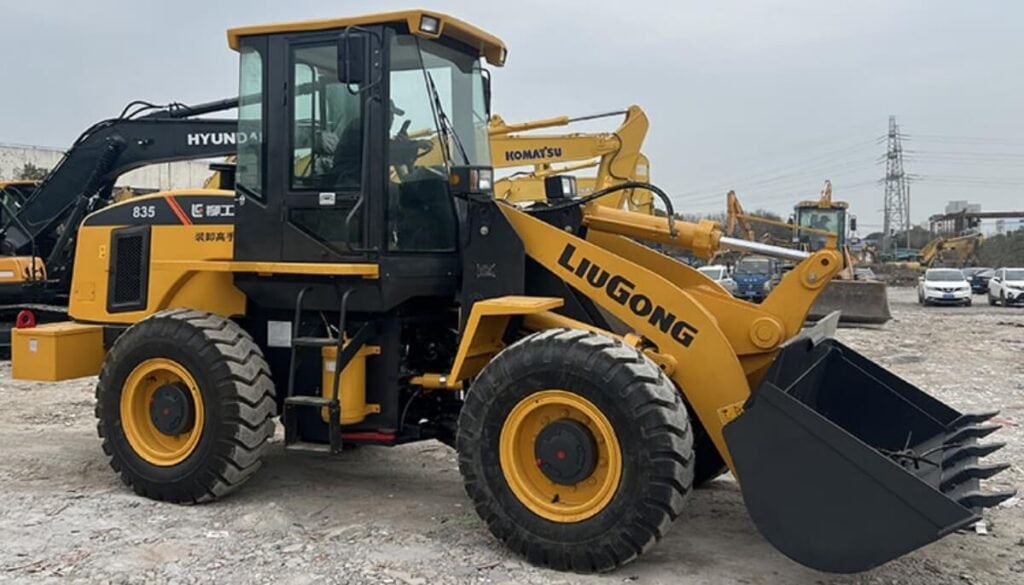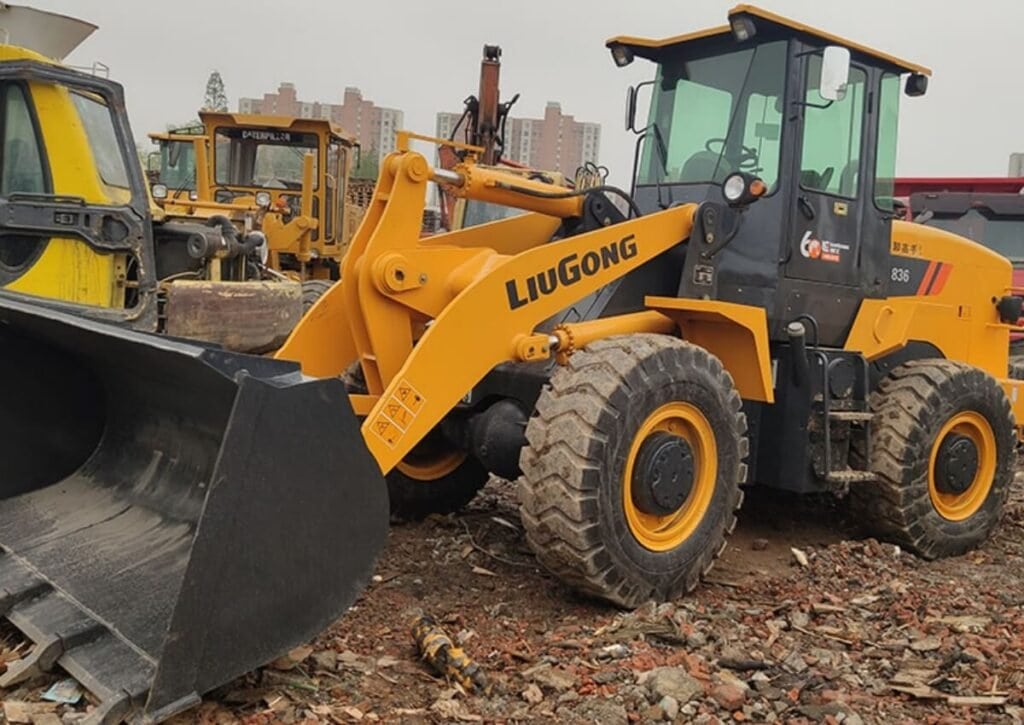
مقدمة
Before purchasing a used loader, conducting a thorough inspection is crucial to ensure its performance and value. A meticulous used loader inspection process can help you avoid potential issues and guarantee that your investment yields good returns in the future.
While ensuring the used loader is in proper working condition, you also need to consider various factors, including its appearance, performance, and maintenance records. Next, we will explore used loader inspection checklist for your reference.
Continue reading to learn how to systematically check the key components of a used loader.
Used Loader Inspection-Exterior Condition
Begin by doing a thorough walk-around to inspect the condition of the used loader’s exterior. Look for rust, dents, or damage to the body and overall condition, as this can be an indication of how the loader was cared for.
The better the condition of the exterior, the better the used loader was probably taken care of, and the longer it’s going to last you.
Pay attention to the condition of the paint and look for any visible welds or repairs. If the machine is dented and banged up, it may have been treated a little bit more roughly than you want.
استخدام محمل Inspection Checklist of Exterior Condition
A thorough exterior condition inspection of a used loader is essential for assessing its overall health and potential repair needs. Below is a detailed checklist to guide you through this crucial part of the purchasing process.
| Inspection Area | Items to Inspect | ملحوظات |
| Frame and Structure | Visual Check: Look for any visible cracks, dents, or deformities in the frame. | A straight frame indicates good structural integrity. |
| Welds and Joints: Inspect all welds for signs of stress or failure. | Cracked welds may need significant repairs. |
| Body Panels | Surface Condition: Check for rust, corrosion, or paint peeling. | Surface rust can be cosmetic but may indicate deeper issues. |
| Alignment: Ensure body panels fit properly; gaps may indicate damage. | Misalignment can affect operational performance. |
| Paint Condition | Overall Appearance: Assess the condition of the paint for fading or chipping. | Poor paint condition might suggest lack of maintenance. |
| Touch-Up Areas: Look for areas that may have been repainted. | This can indicate previous damage or repairs. |
| الإطارات | Tread Depth: Measure and assess the tire tread for wear. | Adequate tread is vital for traction and safety. |
| Sidewalls: Inspect for cuts, cracks, or bulges in the tires. | Damage may require immediate replacement. |
| Attachments and Bucket | Condition of Cutting Edges: Check for wear on bucket edges and teeth. | Worn edges may need replacement for effective operation. |
| Pins and Bushings: Inspect for excessive wear or movement in attachment points. | Loose attachments can affect performance and safety. |
| Engine Compartment Access | Covers and Hoods: Ensure access covers are secure and functional. | Check for damage that might affect access to the engine. |
| Lights and Indicators | Functionality Check: Inspect all lights and indicators for functionality. | Ensure all lights work for safe operation, especially in low visibility. |
| Hydraulic Lines and Fittings | Condition: Look for signs of leaks or wear in hydraulic lines. | Leaks can lead to performance issues and indicate poor maintenance. |
| Connections: Ensure all fittings are secure and free from corrosion. | Loose or corroded fittings may lead to system failures. |
| Safety Equipment | Reflectors and Safety Lights: Inspect for condition and visibility. | Ensure they are present and functional for compliance and safety. |
Conducting a thorough exterior condition inspection of a used loader is crucial for identifying any potential issues before making a purchase. By carefully examining the frame, body, tires, and other exterior components, you can gain valuable insights into the machine’s overall condition and its suitability for your needs. This proactive approach will help you make a more informed buying decision and potentially save on future repairs.
Engine and Components
Engine Condition:
Look at the engine. Is there oil all over the place? Are there different covers missing? If the engineof the used loader is clean, then the machine has probably been taken care of better.
Check the engine mounts and connections for signs of wear. Listen to the machine too. Do you hear anything that sounds odd?
Fluid Levels:
Check the oil, the antifreeze, the hydraulic fluid, and the transmission fluid levels.
Low levels can tell you that the machine may not have been taken care of that well.
Don’t just look at the levels, look at the conditions of the oils. If they’re dark and black, that could mean the machine hasn’t been taken care of very well.

Hydraulic System Inspection
Hydraulic Hoses and Fittings:
Look at the hoses. Are they cracked and leaking? Are all the fittings tight and not showing signs of damage? If the machine has been taken care of, it would be less likely to have those issues.
The hydraulics are a very important part of the machine. They move the bucket, and if they’re not maintained, you’re going to have more problems than you need.
Leaking hydraulic fluid can be a big problem and make for some expensive repairs.
Performance Testing:
Operate the machine to see how well it works. Check that the bucket goes up and down and that it tilts and everything works just like it’s supposed to.
The hydraulics are important, so make sure that everything works.
Listen for any funny noises while you’re running the machine. Any odd sounds may indicate that something is wrong.
Operational Check
Starting and Running:
Watch how the machine starts. A smooth startup of the used loader without a lot of smoke is a good sign. How easily and reliably the machine starts will tell you a lot about the engine.
Listen for anything strange that happens when you start the machine up—knocking or sputtering—that could be an indicator of issues.
Functional Test:
Run the used loader and check all the controls. Make sure the bucket goes up, tilts, and everything works just like it’s supposed to.
You want to test the machine to make sure it’s going to do what you need it to do for your job. If something doesn’t work the way it’s supposed to, you’re going to have a big problem later.
الكابينة وعناصر التحكم
Interior Condition:
Take a look inside the cab of the used loader. Is it worn out? Is it comfortable and clean? A clean, well-kept cab tells you that the machine was taken care of and that it’s going to be more comfortable for the operator to work in it.
The more comfortable the operator is, the safer and more efficient they’re going to be when they’re operating the machine. Also make sure that the operator has the right kind of visibility and can access the controls they need to use the machine effectively.
Control Functionality:
Make sure the controls and gauges work. You have to test to make sure that the machine works the way it’s supposed to.
If the controls don’t respond the way the operator needs them to, that’s going to be a big problem down the road.
Undercarriage and Frame
Frame Integrity:
Look at the frame for cracks and stress. You don’t want to see any of that going on. If the frame of the used loader is damaged, the loader’s not going to be very stable, and you’re going to have a problem later.
The frame is what the whole machine is built on, so it’s pretty important.
Take a look for repairs, and try to figure out whether there’s been welding or other work done on the frame. That can tell you that something’s gone on with the machine in the past.
Undercarriage Wear:
Look at the undercarrige and the axles and the supports. You don’t want to see any signs of significant wear there because that could lead to a really big bill later.

Maintenance Records
Documentation Review:
One other thing to consider is asking for maintenance records and service records.
If they can provide you with records of the regular service, parts that were replaced, and any other major repairs that have been done, that’s going to help you make a decision.
Previous Repairs:
Consider significant repairs or replacements of the used loader. Understanding the prior issues can help you understand potential future issues.
Final Considerations
Professional Inspection:
Get a mechanic to look at it. The sooner you bring in a professional to inspect the machine, the more chance that they’re going to be able to tell you if there’s something wrong with it that you don’t know about.
Rather than spending a bunch of money and giving yourself a big headache down the road, it’s worth investing a little up front to make sure that your purchase of the used loader is going to be sound.
Negotiation Factors:
Use what you find from your inspection to negotiate the price. The more you can show them what’s wrong, the more leverage you have to get the price down.
خاتمة
Doing a full inspection is key to making the right decision when you’re buying a used loader. You can look at so many different things— the engine, the way the machine starts and runs, and the maintenance records. By doing a thorough job checking the machine, you can make sure that your investment is going to be able to do what you need it to do and can do it reliably. Doing a good job at this now is going to save you money and headaches later.